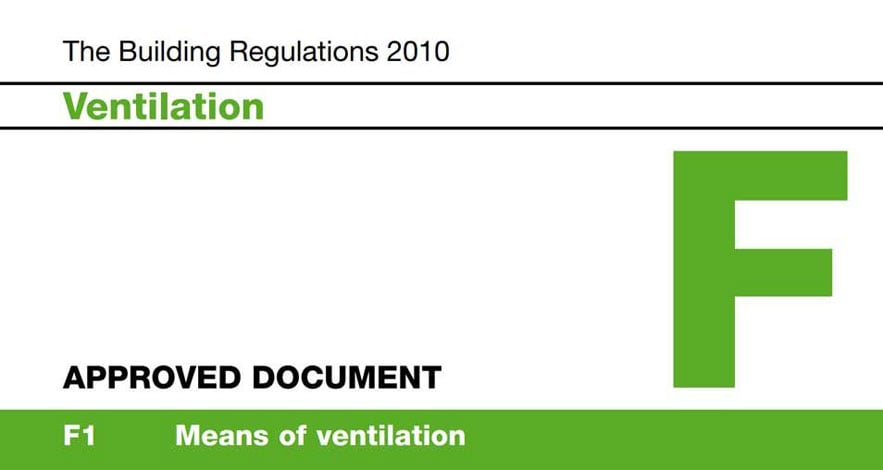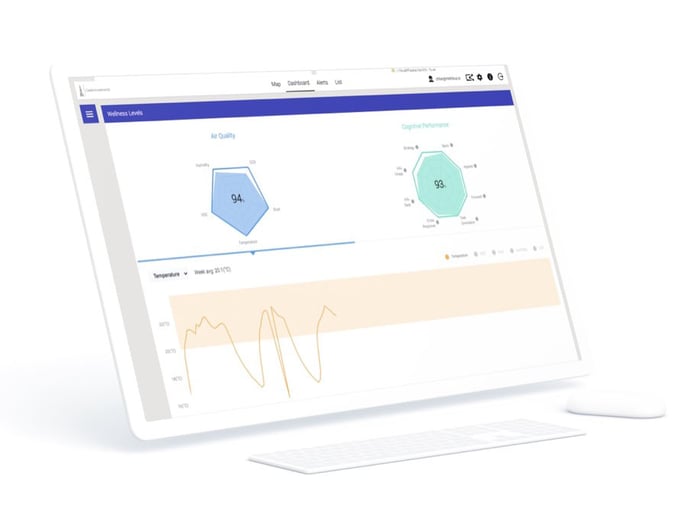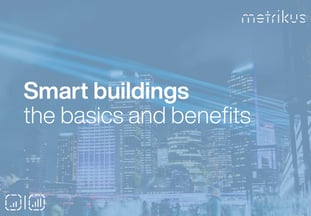Building Regulations Part F: everything you need to know
The majority of building works carried out in England need to comply with the rules set out in the Building Regulations 2010.
There are documents that give practical guidance on how to stick to these regulations, including Part F, which focuses on ventilation.
On 15th June, significant changes to Building Regulations Part F came into effect:
- Approved Document F – Ventilation – Volume 1: Dwellings
- Approved Document F – Ventilation – Volume 2: Buildings other than dwellings
If you don’t have time to read over 100 pages of very technical information and you’re wondering what the f has actually changed with Part F, you’ve come to the right place.
In this article we explain what the new regulations mean, which spaces they apply to, how they will impact you, and how we can help.
1. How has Part F changed?
Part F covers a very important topic that’s overlooked: ventilation.
Good ventilation is critical for the health and wellbeing of a building’s occupants, while efficient ventilation is vital to regulate energy costs.
The right ventilation can:
- Dilute and remove airborne pollutants
- Avoid excess humidity
- Control thermal comfort
To find out more, check out our blog post exploring how we can improve indoor air quality and create healthier spaces.
What are the key changes?
Under the revised Part F regulations, whole building ventilation needs to meet a standard of 10 litres of fresh air per person per second, or one litre per second per square metre – whichever is highest.
Common spaces also need natural ventilation, with openings at least 1/50th of the floor area, or mechanical ventilation to supply 0.5 litres of fresh air per second per m2 of the common floor space area.
The changes to Part F also mean that for the first time, indoor air quality monitoring will be regulatory for the design and construction of non-domestic new builds in England. Specifically, the change means that CO2 will need to be continuously monitored.
The key aims include:
- Ensuring ventilation is appropriate to reduce the risk of condensation and indoor pollution
- Securing the health and safety of the building's users or occupants
What are the sensor requirements?
There are some specific requirements for the CO2 monitors themselves, which need to be:
- Mains powered
- Non-dispersive infrared (NDIR)
- Placed at breathing height and away from windows, doors or ventilation openings where possible
- Placed at least 500mm from people where possible
What will happen if the regulations are ignored?
The local authority has the power to prosecute, enforce an unlimited fine and can impose rectification of the work for up to two years following its completion. And considering the fact that ventilation work happens during the early stages of construction, making adjustments following completion could end up being extremely costly.

2. Which spaces need to comply with Part F?
As it’s being phased in, the changes to Part F won’t apply to work subject to a building notice, a full plans application or an initial notice submitted before 15th June 2022, as long as the work is started on site before 15th June 2023.
But as of 15th June, to abide by the new rules, building designs need to consider ventilation from the outset. Construction work is always checked by an approved building inspector at different stages of the works to ensure compliance.
There are some specific details about which type of buildings do and don’t need to comply with the new regulations, which we’ve summarised below.
If you already know whether or not your building is included, skip this part and head to the sections about what Part F means for you and how Metrikus can help.
Historic and traditional buildings
For the purposes of Part F, historic and traditional buildings include:
- Buildings listed in accordance with section 1 of the Planning (Listed Buildings and Conservation Areas) Act 1990
- Buildings in a conservation area designated in accordance with section 69 of the Planning (Listed Buildings and Conservation Areas) Act 1990
- Other historic buildings with a vapour-permeable construction e.g. those built with wattle and daub, cob or stone, and constructions using lime render or mortar
These buildings should comply with the ventilation standards where possible, but there are some exceptions. For example, if the works would:
- Unacceptably affect the significance of the listed building, conservation area or scheduled monument
- Increase the risk of long-term deterioration of the building fabric or fittings
A new extension to a historic or traditional building should comply with Part F unless its external appearance or character needs to be matched to the original building.
Minor works
Minor works need to comply with the relevant requirements of the Building Regulations, but the building control body doesn’t need to be notified.
For mechanical ventilation and air conditioning systems, minor works include:
- Replacing parts
- Adding an output or control device
- Providing a self-contained mechanical ventilation or air conditioning appliance when all of the following apply:
- Any electrical work is exempt from a requirement to give advance notice to a building control body
- Testing and adjusting the system would not affect its energy efficiency or would not be possible
- The appliance is not installed in a room that contains an open-flued combustion appliance
For emergency repairs, if you can’t notify the building control body in advance, the building control body should be notified as soon as possible.
Living and working units
A unit that contains living accommodation and commercial space – like a workshop or office – is considered a dwelling if the commercial part can be reverted to domestic use.
This is the case if all of the following apply:
- There’s direct access between the commercial space and the living accommodation
- The commercial space and living accommodation are within the same thermal envelope
- The living accommodation comprises a substantial proportion of the total area of the unit
A large non-domestic building that contains a small flat for a manager is not treated as a dwelling. But a dwelling that contains a room used as an office or utility space is still treated as a dwelling.
Mixed-use developments
If a dwelling is constructed as part of a larger building that contains other types of accommodation – otherwise known as a mixed-use development – you need to refer to the two volumes of Part F as follows.
- For guidance on each individual dwelling, use Volume 1
- For guidance on the non-dwelling parts of the building, like communal rooms or retail space, use Volume 2
Right, now we’ve spent enough time dwelling on which buildings are covered by Part F (pardon the pun), let’s go into which rooms it applies to.
Which rooms does it apply to?
In new buildings, CO2 needs to be monitored in the following types of room:
- Occupiable rooms in offices
- Occupiable rooms where singing, loud speech, aerobic exercise or other aerosol generating activities are likely to take place e.g. gyms, theatres, pubs, nightclubs
- Occupiable rooms where members of the public are likely to gather e.g. hotels, indoor sports venues, concert halls
- Occupiable rooms with low temperatures and humidity levels e.g. cold stores
It doesn’t include areas like:
- Bathrooms
- Sanitary accommodation
- Utility rooms
- Building services plants
- Storage spaces
The regulations also don’t apply to small spaces up to 50m2/125m3, or large spaces over 320m2/800m3.

3. What does Part F mean for you?
Complying with Part F is clearly vital for regulatory compliance, but it also presents an exciting opportunity.
The guidelines mean that CO2 data needs to be collected, and you have the chance to use this data to your advantage.
Whether you’re a building owner, facility manager, or a sustainability officer, indoor air quality monitoring can bring about a whole host of benefits.
What does Part F mean for building owners?
As we’ve already covered, if you own a new building like an office, gym or hotel, you need to make sure CO2 levels are being monitored in occupiable rooms.
This means you’ll have the data you need to prove that you’re providing a safe, healthy space that prioritises those within it.
A World Green Building Council survey found that:
- ‘Healthy’ buildings were worth at least 7% more than standard ones
- 46% of respondents reported they were easier to lease
- 28% said they could command premium rent
So, complying with Part F could actually help you to attract occupiers and charge premium rent, which will very quickly outweigh the original cost of installing the sensors.
What does Part F mean for facility managers?
If you’re a facility manager going into a new building, you need to ensure the ongoing monitoring of CO2 levels.
Access to this data will help you to manage the balance between ventilation, thermal comfort and energy expenditure. It can also help you to identify any issues with an HVAC system proactively, driving efficiency and reducing maintenance costs.
Another bonus of indoor air quality monitoring is boosting occupant health, wellbeing and productivity:
- 70% of employees believe poor air quality in their workplace is having a negative effect on their day-to-day productivity and wellbeing
- Improved ventilation with lower CO2 levels can boost employee productivity by up to 11%
- 66% of companies see a Return on Investment (ROI) on their health and performance initiatives
What does Part F mean for sustainability officers?
If you’re a sustainability officer going into a new building, these changes are good news for you too.
Part F basically means that CO2 levels need to be monitored in your space, and this data can be used to optimise your building’s energy usage, especially when combined with other data.
- Buildings and construction are responsible for 39% of global carbon emissions, with energy used to power buildings accounting for 28%
- Spaces are typically underutilised by 30-40% every day, so energy is inadvertently wasted despite some areas being completely empty
- Using CO2 sensors to control when the HVAC system runs can reduce energy consumption by 15%
4. How can Metrikus help with Part F?
We can not only ensure you comply with Part F, but help you to take action to improve your indoor air quality.

- Identify the right sensors for your building
We work with a wide range of technology partners, so our experts can listen to your specific needs and recommend a sensor that’s right for you. And of course we will make sure it complies with the requirements set out in Part F too.
- Connect the sensors to the Metrikus platform
Once the sensors have been installed, they can immediately be connected to the Metrikus platform. This allows you to see all of your CO2 data in one place, with graphs, charts, analytics and more. And the best part is – it’s incredibly easy for the data to be accessed by any member of your team.
- Provide real-time insights
What’s the point in monitoring indoor air quality if you can’t get real-time insights? With the Metrikus platform, you can see granular detail, both real-time and historic, around CO2 levels to identify any trends, hotspots, or problem areas.
Our platform also not only shows your own CO2 levels, but gives guidance about what these values should be, and how the current values could be impacting occupants.
- Improve air quality
We can set up smart alerts to notify you when CO2 levels deviate from their optimal zone, so that action can be taken to maintain a healthy indoor environment at all times.
This can have a huge impact on occupant wellbeing and productivity, as well as helping you to quickly identify any issues with your HVAC system.
- Add more datasets
CO2 monitoring can easily be combined with our occupancy or energy monitoring solutions to give you more insights about how your space is being used, and what can be done to increase energy efficiency.
Combining data sets in this way can generate huge benefits – check out what we did at Accenture’s headquarters in Madrid to see an example of this in action.
What are you waiting for?
Complying with Part F might seem daunting, but it’s actually a great opportunity to understand and improve your indoor air quality.
Our cost-effective, scalable solution is already helping companies around the world to monitor CO2 levels, and we’re ready to help you to do the same.
Want to get prepared for the changes to Part F? Speak to our team today.




